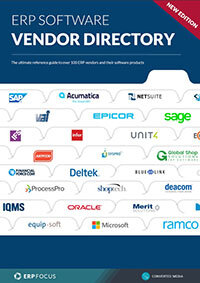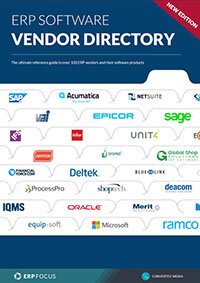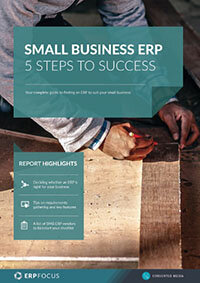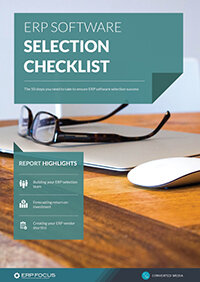The case for flexible ERP systems
ERP software vendors often talk about best practices. And what’s not to like?
Best practices can speed up ERP implementations by providing an existing framework to use. This prevents the need to reinvent the wheel for functionality that is widely used in other companies. As the word “best” implies, it also provides a solution that has been proven successful by other companies, and lowers some risks associated with poor solution design.
The problem with best practices is that most businesses are complex. In addition to industry requirements, ERP solutions must meet specific requirements for vertical segments and in many cases, sub-segments. There are also company-specific requirements that must be considered. I call this The Long Tail of Customer Requirements, as shown in the chart below. Best practices seldom go far enough to meet all of a customer’s ERP requirements. Unfortunately, most current supplementary solutions for going beyond best practices can hurt a business in the long term.
The long tail of customer requirements
ERP software vendors vary greatly in best practices offered to meet the long tail of customer requirements. General ERP systems, or even industry-specific ERP solutions, brought to the level of type of work performed (e.g., manufacturing, education, software) is often too broad to be meaningfully applied to a specific business. They simply don’t help.
Vendors that go deeper by offering vertical (e.g., life sciences, consumer products, high-tech, etc.), or even sub-vertical segment (e.g., life sciences medical device manufacturing) best practices can provide greater value. However, in these examples, requirements met by the software seldom exceed 90 percent because each company has its own unique needs.

Find the right ERP for you with this comprehensive ERP vendor directory
Some vendors try to downplay the value of these unique needs, and suggest best practices are the right solution and customers should modify their processes to align with the approaches. That doesn’t work because these differences are often part of, or support, a company’s unique differentiation, which is what ultimately makes it competitive in the market. Adopting “best practices” in favor of a unique process can destroy the very differentiator and value a company delivers to customers in the first place.
Given the importance of understanding and respecting unique business processes that create value, why would ERP vendors steer customers to solutions that stops at best practices?
One reason is a lack of suitable alternatives. If a company is not going to use best practices, how will it get the system to support its needs? Traditionally, the answer has been customization.
The true cost of ERP software customizations
ERP customizations are like making a deal with the devil. They can provide the fit desired today, but in return, they are costly to create, and even more expensive to maintain.
ERP software customizations can take considerable time to implement, and that delays benefits and ROI while also creating more rigidity. Customization is like pouring concrete: given enough time and effort, you can get it to fit any form, but once it settles, it’s is almost impossible to change. As vendors release new versions of their software, customization can make upgrading incredibly difficult. Each customization must be tested in the new release, and many will break and need to be rebuilt.

Customizations are not sustainable. In essence, you are trading fit tomorrow for fit today. In a world where the pace of change is accelerating, this is not a fair trade.
Flexibility for fit…today and tomorrow
The goal of customization is right, but its methods are not. Luckily, flexible ERP systems are being developed that can leverage best practices and provide the benefits of customization, including last-mile fit, without drawbacks such as excessive costs and version lock-in. Furthermore, flexible ERP solutions can provide a rapid response to change, and this is increasingly important as the pace of change within many industries is accelerating.
These systems, which are often No Code or Low Code, provide a way to extend the ERP solution through visual drag-and-drop or light scripting. They are built on micro-services to create a loosely-coupled system. Parts of the system can be extended without breaking the whole, and can be upgraded independently. This allows for smaller, benefit-targeted upgrades versus the traditional monolithic big bang approach.
Finally, flexible ERP systems create a platform that other applications can use to leverage the rich enterprise data at the core of the system.
While it makes sense to focus on current business requirements when selecting an ERP solution, recognizing those requirements are likely to change over time is a critical selection criteria that is often ignored. Since we don’t know what these future requirements will be, our best solution is to select a flexible ERP system. Otherwise, many companies will likely find that they are stuck in a repeated cycle of ERP replacement as their requirements change over time.
Free white paper

ERP Software Vendor Directory
Put the most comprehensive ERP vendor directory on your desk today

Featured white papers
-

ERP Software Pricing Guide
Get the latest pricing information on over 80 popular ERP systems, and learn how to budget for your ERP project in our free guide
Download -

Small business ERP: five steps to success
Download -

60-Step ERP Selection Checklist
Get the comprehensive checklist for your ERP selection project
Download
Related articles
-

The best ERP systems for process manufacturing
Consider these ERP systems when selecting your next process manufacturing ERP
-

CMMC Compliance: What Aerospace and Defense Manufacturers Need to Know
Key insights on CMMC compliance, deadlines, and securing DoD contracts with CMMC 2.0 certificatio...
-

5 ERP pricing definitions you need to understand
Have you mastered the ERP pricing lexicon yet? Getting to grips with these five definitions is a ...

